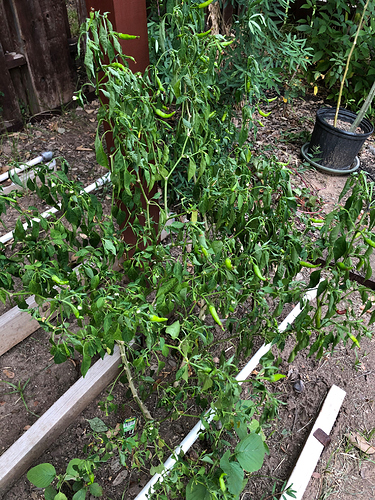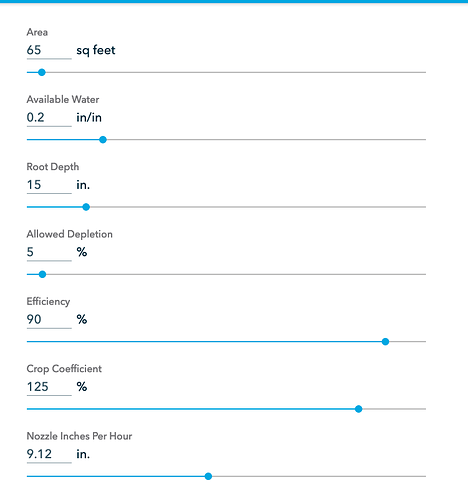I spent the weekend building a spreadsheet to reverse engineer rachio and try to build a prediction model, that i can correlate with my actual water consumption to try to get a grip on where water is spent and why it is spent there.
I actually think rachio is a bit complicated to get right, but once you get it right it seems reasonable.
the UI uses scientifically correct language that i think is inaccessible to many regular folks. I think the language can be simplified by a lot.
Much of the language makes the device needlessly inaccessible
Let me make an example. allowed depletion could be told with simpler and more descriptive language that has fewer domain knowledge assumptions in it. ie.
management allowed depletion = do you want frequent and shallow watering or deeper infrequent watering? That is basically what this affects. It doesnt’ call it that, but it is what it does. The tricky part it says % and starts at 50%. So it means that once 50% of the water in the soil for the root depth in the zone has been consumed it will start to water again to replenish the soil. But 50% is easy…
Setting it at 10% is trickier, does that mean that when 10% has been consumed we replenish with water? Or does it mean that when it is 10% water left in the soil rachio starts to replenish. Nothing in the UI tells you which it is. This could use more obvious language (or a help button to explain which it is).
Now, i come to understand in crop science circles it means exactly one thing. But in hobbyist and back yard gardening circles can you really make that assumption? I think this is a great example of how language gets in the way of understanding.
My point is that the language must not make the product inaccessible -and i think this is the point that the original poster is making. Me, i’m an engineer so i took the time to read up (and i got help from the retired engineer in this post to lay out the math for me to understand).
My criticism:
Root depth and crop factor is essential to get right. yet there is no real database one can use to lookup common crops like citrus trees, hybrid roses, tomatoes, cucumbers, raspberries etc. There is no community database on the forum for users to provide their insight into crop factors and root depth. I spent an hour trying to figure out root depth of a pomegranate and a fig tree together with their crop coefficiencies. Rachio provides no help when those two are in the same zone.
Grasses seems to be off. I verified the default vs. an sample, and rachio’s default was much deeper roots than my sample. Since there is no community validation, its hard to tell if the default is typical in the community or if it is high/low -this is where social networks shine. "others using rachio and overrides the setting typically set this to this number. In your plant hardiness zone (as calculated from your zip code) users typically set this to X depth for the type of crop you listed.
These are inputs to get to a mathematical model of the crops water need and how that can be applied to the soil.
I also find that you either measure each zone carefully and use a flow meter to calculate the inches per hour of nozzle output (which i did, since i have lots of drip lines), or you do a catch cup test (which only works if you have rotators). There is little guidance and help to get this rock solid, and i think more can be done to guide the user here. I think you can be a bit explicit in expert mode and say that this needs to be really correct or your water schedule will be wrong. Use better defaults and more types of emitters, drip lines etc (ideally identified by manufacturer name/model) to reduce error rates.
What i feel is missing:
i’d love if i can get a zone to tell me when i click on it: this zone needs 2 inches of water of irrigation this week under current weather conditions. you kind of have to click into moisture zones and add up a week of evap to get that right -its not user friendly.
I would love it even more if it said, using historical data this zone should use this many inches of water in october, XX in november, YY in december.
Fundamentally I’d love to see how seasons and historical data would affect my zone with the crops in that zone.
I would use that by taking an unused zone and use that to plan planting of crops using fictional values by cloning my settings from an already defined zone but change the crop type to see what happens. that would help me in planning to be more waterwise, which i would love.
Rachios issue isn’t science, its the user interface
I’m convinced about this. The key work you need to do is guide the customer, have more validations on inputs any which way you can do it, and provide more feedback loops that connects the input to the real world to make it so it has fewer errors.
I haven’t given it a ton of thought for how to simplify the user interface but to me there are a few super important variables that must be done right:
root depth (which for your exact crop you typically can lookup on the internet, adjust for maturity)
allowed depletion
crop coefficient (which for the most part you can look up for your exact crop on the internet)
Nozzle inches per hour (which you should use cups for, or a flow meter and measure the zone square footage that is covered by irrigation very precisely).
The other stuff matters to, but if you get any of the above really wrong it really screws up your yard.
I wish that there was reports that i could run that states “using historical data, this zone would get this much water per week for the next 4 weeks”. I want to make it easy to catch mistakes of either over or under watering on a per zone basis -and that is really hard in the current UI. Its focused on the reporting of here and now + historical but not so much on forecasting the big picture.
Anyway my few cents. And i’m not at the expert level at some of the others in this thread. Just starting to truly get hang of what flex daily really is doing.






